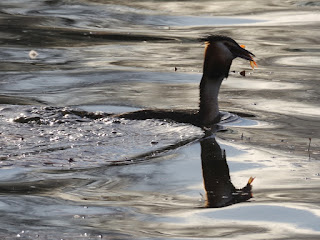A political demonstration had brought crowds trailing round the Serpentine, and the small birds had left their usual bushes near the bridge and moved to a bramble patch near the Queen's Temple, where a Great Tit came out expecting to be fed.
A Blue Tit was waiting in a nearby yew tree.
Surprisingly, there were Redwings on the Parade Ground only yards from a crowd being harangued through a loudhailer.
And a Pied Wagtail was wading imperturbably in a puddle.
A pretty background of brown hornbeam leaves gave an excuse for publishing yet another picture of a Robin.
A Carrion Crow was shining in the sunlight and looking very pleased with itself in a tree near the Dell.
Charlie and Melissa were not to be seen. Perhaps someone has spoken sharply to them about eating Egyptian babies, and they are in a huff.
But there were lots of Jays all over Kensington Gardens.
Two Coots were fighting in the middle of the Serpentine.
The sun lit the fins of a perch for the last time as it was swallowed by a Great Crested Grebe.
At Peter Pan, the Mallard with a white front was looking positively luminous.
The female Little Owl was basking in the sunshine in the lime tree near the Henry Moore sculpture.
For a change, it was the male Little Owl who was looking out of the oak tree near the Albert Memorial. How much smaller he is than his mate.
Two Treecreepers were climbing up the trunk a few feet away.













It's remarkable that in spite of Egyptians' aggressiveness with each other, often-seen protectiveness of their young near people, who they may also attack, and joint parental guard, they still lose young to smaller Carrion Crows. Jim
ReplyDeleteAfter a frantic bout of protectiveness, they lose concentration and let their young stray, and it is then that crows and gulls attack. Sometimes one, or disastrously both, parents, are distracted by a territorial dispute and rush off, leaving their brood unprotected.
DeleteMaybe they find it hard to de-domesticate properly in temperate climes and like the warmth and perceived security of living close to many other waterfowl, but as a result tend to succumb to territorial tensions at the wrong moment. Jim
DeletePark lakes must be a crowded environment for them, increasing territorial tensions. The population has fallen a bit in recent months, possibly through emigration. They are certainly clueless about temperate climes, completely failing to understand the seasons.
DeleteGreat stories and photos! You really know your park and it's habitants :D
ReplyDeleteMe and my friend -we are both nature photographers from Finland- are coming to visit London in the end of the week and if we are lucky enough we'll meet you too in the Kensington Park - beside all those bird-species which have migrated out of the way of our winter! (https://jti.kuvat.fi/kuvat/)
I'm always happy to meet people and take them round. My usual meeting place and time are at the south end of the Serpentine Bridge at 10.30 am. Just tell me which day you are coming, and I'll be there.
DeleteLovely pictures on your page.
Ralph is always very generous with his park bird knowledge and definitely worth catching up with him in the Kensington Gardens and Hyde Park outings. Many of the birds recognize him and will approach closer than you might ever expect, so enjoy the advantage.
ReplyDeleteHi Ralph!
ReplyDeleteWe'll be at the south end of the Serpentine Bridge at 10.30 am on friday! Looking forward to see You! -j-
OK, see you there.
Delete